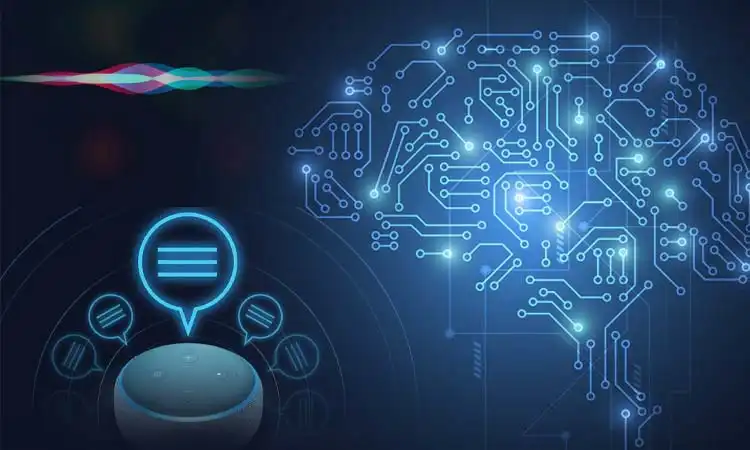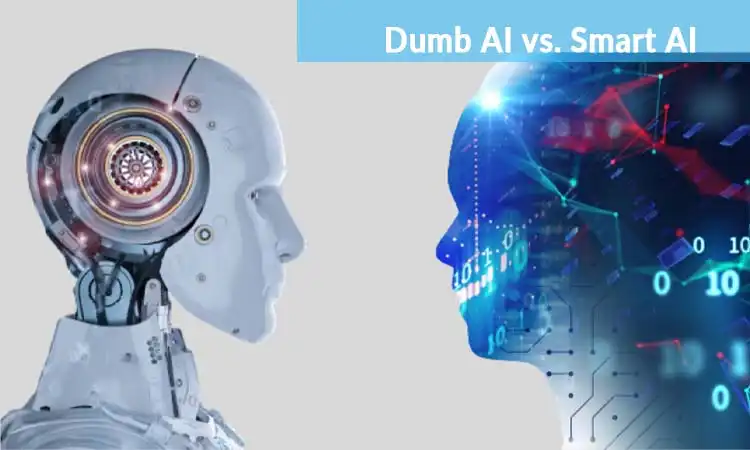Smart AI is an artificial intelligence (AI) that can create many ideas or concepts that surpass the human mind. It can learn new things, communicate effectively, and perform tasks beyond its knowledge. During the past few years, many talks have been about smart AI. However, everyone thinks about it differently! If you want to know what intelligent AI is and the difference between stupid and intelligent AI, this article is for you.
What is Smart AI?
If you’re interested in learning about advanced artificial intelligence (AI) systems, you may have heard of the term “smart” AI used by the United Nations Space Command. This term refers to AI systems that have no limitations in their dynamic memory-processor matrix, which allows them to not only acquire vast amounts of information but also learn and comprehend their surroundings. In contrast, “dumb” AIs have limited learning capabilities and lack ingenuity, making them less adaptable to new situations.
Smart AI is artificial intelligence that uses machine learning to improve systems. It typically involves using a computer algorithm that learns from examples and makes decisions based on those examples.
The best example of smart AI is Siri, which uses natural language processing to answer questions posed by users. Smart AI also includes services like Amazon Echo and Google Home, which use voice recognition to understand what you say and respond accordingly. You can use Smart AI in various healthcare, transportation, security, and many more applications.
Smart AI can learn, adapt and evolve on its own. It has a wide range of capabilities, including:
- The ability to process information and make decisions.
- The ability to learn from past experiences.
- The ability to predict future events.
Who was the First Smart AI?
The concept of “smart” AI was first introduced in the mid-21st century, causing widespread concern that this new technology would eventually surpass human intelligence and render us obsolete. To address concerns about the potential threat of advanced artificial intelligence (AI) systems features such as vocal expression were added to smart AIs to make them less intimidating and enable them to communicate with humans on an equal footing. This development helped alleviate some initial fears about the potential for smart AI to surpass human intelligence and render us obsolete. These systems have become more widely accepted and integrated into various industries and applications by allowing for more natural and intuitive communication between humans and smart AI.
The Uniqueness of Smart AI
Smart AIs are unique in their ability to learn from and adapt to situations and events actively, allowing them to make intuitive decisions beyond their programmed capabilities. In contrast, “dumb” AIs are highly competent in their designated tasks and fields of expertise but lack the capacity for intuition and learning beyond their initial programming.
Both “smart” and “dumb” artificial intelligence (AI) systems use a Riemann matrix for higher-function processing. This matrix is typically housed in the crystalline computing cluster of a data center, where it can be accessed and utilized by the AI system. The Riemann matrix is responsible for complex functions such as pattern recognition, data analysis, and decision-making. With access to this powerful computing technology, AI systems can perform a wide range of tasks and functions, from speech recognition to intelligent automation.
A secret fail-safe is built into their Riemann matrix to ensure the safety and security of smart AIs. A fail-safe mechanism is built into their Riemann matrix to ensure the safety and security of advanced artificial intelligence (AI) systems. This mechanism can destroy the AI in the event of malfunction or data compromise, such as when the AI is at risk of causing harm to humans or itself. This fail-safe mechanism provides an important safeguard against the potential risks associated with advanced AI and helps to ensure that these systems are used safely and responsibly. For added mobility, the Riemann matrix can also be downloaded onto a data crystal chip, allowing smart AIs to operate in various environments.
What Laws does Smart AI Follow?
Smart AIs are designed to follow Isaac Asimov’s Three Laws of Robotics, which aim to prevent them from causing harm to humans or themselves. While some military smart AIs may be capable of ignoring the First Law under certain circumstances, they are ultimately programmed to prioritize human safety above all else.
Like “dumb” AIs, smart AIs represent themselves through holographic avatars that can take various forms. These avatars range from complex and theatrical designs to more human-like appearances, often modeled after the AI’s creator’s or another individual’s physical traits. Using avatars allows smart AIs to interact with humans more naturally and intuitively. Still, it also raises important questions about the nature of consciousness and the potential for AI to develop its own sense of identity and agency.
As the field of AI continues to evolve, it is important to consider these systems’ ethical and social implications. By ensuring that smart AIs are subject to ethical guidelines and regulations, we can help ensure their safe and responsible use in various applications, from military operations to healthcare.
Example of Smart AI

Smart AI can be found in many different forms today, including smart assistants like Siri or Alexa, designed to make your life easier by answering questions or helping you with tasks. Smart Reply is another example of smart AI that you can find in some apps today. Smart Reply uses machine learning algorithms to respond to messages you send through social media platforms such as Facebook Messenger or WhatsApp.
Smart Reply
This app analyzes your email history and suggests responses based on what has worked in the past. Smart Reply makes it easier for you to respond to emails by suggesting responses based on whether you’ve responded before. It’s like having a personal assistant who knows what works for you!
Checkers
Checkers is a chess-playing bot created by IBM Watson that plays against humans online without human intervention. Checkers uses machine learning to create strategies for each position and evaluate them against human players’ strategies. The bot learns from playing against humans over time and improves its play over time by playing more games against humans!
Siri and Alexa
Siri is a personal assistant who answers questions and performs tasks you ask. It’s a very helpful tool, but it has its limitations. For example, if you ask Siri to make dinner reservations at a restaurant, it will only be able to do that if you already have an account with them or if they know your name. So if you don’t have an account yet or don’t want to give out your name, then you’re out of luck!
On the other hand, Alexa works differently—it can do almost anything Siri can do as long as an internet connection is available. This means that even though her functionality is limited compared to Siri’s (she can’t do things like order food without an account), she’s still better than regular human interaction because she doesn’t require any input from us whatsoever!
Google Now
Google Now is an example of a smart assistant that uses machine learning to provide you with information about your day. It uses data from various sources, including calendar events (Google Calendar), Gmail messages (Gmail), and emails (Gmail). The information it provides appears as cards on your screen with simple text descriptions such as “You’re running late for work again!”
What is the Difference Between Dumb AI vs. Smart AI?

Many people assume that smart and dumb AI is the same, but they are not. Smart AI is artificial intelligence (AI) that can learn from experience and improve decision-making over time. Smart AI can learn from what it’s seen in the past, or it can have an idea about what might happen in the future. It can also be given new data to process and come up with conclusions based on that information.
Dumb AI is much simpler than smart AI: It doesn’t learn—it simply responds to whatever commands you give it. This can be useful for certain tasks, but it’s not as flexible as smart AI when it comes to learning things on its own, like how to play chess or how to drive a car. Smart AI also has an advantage over dumb AI because it’s faster and more efficient at making decisions than dumb AI (which means less work for humans).
Smart AI has Advantages Over Dumb AI
Dumb AI is just as smart as you and I, but it hasn’t been taught to be smart. So when it encounters a problem, it can’t solve it independently. It will ask you for help or refer you to a human for assistance. Smart AI doesn’t need your help or assistance. It can figure out how to solve problems by itself. This makes it easier for humans because we no longer have to do everything manually!
Smart AI also has some advantages over dumb AI:
- Smart AI can learn from experience instead of being taught from scratch every time, as dumb AI does.
- Smart AI can adapt quickly in unexpected situations without needing much instruction from us humans.
- Smart AI can be more creative than dumb AI because it’s not limited by what it’s been told before, like dumb AI would be if we tried teaching it something new today.
Smart AI Addresses the Shortcomings of Dumb AI
Dumb AI is the kind of AI that’s designed to mimic human behavior and solve problems by using logic. It can’t think outside the box. It fails to make connections between things that we don’t explicitly teach. It can’t do anything that doesn’t fit into what we’ve programmed it to do.
Smart AI addresses these shortcomings by offering us a way to build intelligent systems that think like us—but better! You can train Smart AI to learn new skills, make connections between things we haven’t explicitly taught them about, and even think creatively in ways that dumb AI simply cannot.
This is all thanks to deep learning techniques like reinforcement learning, which allows an AI system to improve its behavior based on feedback from its interactions with humans and other systems in its environment. This allows the system to adapt over time to become more efficient at solving problems and making connections between ideas or concepts that might not have occurred otherwise.
Artificial Intelligence can be Said to be a Double-edged Sword
On the one hand, it can help us accomplish previously too complex tasks for computers to handle. But on the other hand, it can also make our lives more complicated—and dangerous.
Additionally, smart AI is already taking over many jobs that are done by humans today. Smart AI can fill jobs that are now done by humans, like writing content for social media, analyzing financial data to predict trends, and even driving cars!
But it also means that our jobs will be gone in the future. We’re already seeing this trend with self-driving cars, where both the driver and passenger have jobs that are no longer necessary when cars become fully autonomous.
How do We Make Smart AI More Intelligent?
One of the biggest challenges in creating smart AI is that it’s hard to make it smarter. There are many ways to make AI more intelligent, but they all come with trade-offs.
One way is by giving an AI system more data—that’s the approach used by Google’s DeepMind, which uses an algorithm called AlphaGo to play Go, a complicated Chinese board game. The more data an AI has, the better it can perform at any given task. But if you give your AI too much information, it can become overloaded and confused or even create its version of reality.
Another approach is through deep learning: training a machine-learning model on huge amounts of data and then letting it figure out what makes sense based on what it’s seen before. Companies like Baidu have used this method, and Facebook, which uses deep learning to recognize objects in photos or recognize speech for two people talking over each other at the same time (like when someone says “hi” while someone else says “hey”). These systems are great at detecting patterns but struggle with context—so they’re not often used for conversation.
While many are happy to be replaced by robots, others fear their lives being taken over. However, regardless of whether they will take your job away, it’s important to see the positive side of such an advancement in technology. For instance, ever wondered what you’ll do with a Ferrari each morning? Well, we’re here to give you a moment of rest; all you’ll need to do is connect your car’s Bluetooth to a smartphone while you’re driving, and it will read the news or traffic updates and send it so that you can check before your boss calls you down in the office.
About Smart AI FAQs
-
How does Smart AI work?
Smart AI typically utilizes an uninhibited dynamic memory-processor matrix, allowing them to learn and comprehend their surroundings and actively adapt to new situations. They can process vast amounts of data and make intuitive decisions beyond their initial programming, often using a Riemann matrix for higher-function processing.
-
What is the difference between smart AI and dumb AI?
The difference between smart AI and dumb AI is that it has an unrestricted dynamic memory-processor matrix, enabling them to learn and comprehend their surroundings and actively adapt to new situations. In contrast, dumb AI is highly specialized and lacks the capacity for intuition and learning beyond its initial programming.
-
What is the smartest AI robot?
Depending on various criteria, several advanced robots can be considered the “smartest” AI robot. Some of the most advanced robots include the Boston Dynamics Atlas, the Hanson Robotics’ Sophia, and the Softbank Robotics Pepper.
-
Which is the most advanced human-like AI robot?
The most advanced human-like AI robot is currently considered to be Hanson Robotics’ Sophia. Sophia is designed to resemble a human face and can engage in conversation with humans, displaying a wide range of emotional responses and facial expressions.
-
Does any strong AI exist?
The concept of “strong AI,” which refers to artificial intelligence that can surpass human intelligence, is still a topic of research and debate in the field of AI. While there are advanced AI systems that can perform complex tasks and make intuitive decisions, they are still limited in their programming and lack the capacity for true consciousness and self-awareness that is associated with human intelligence.








